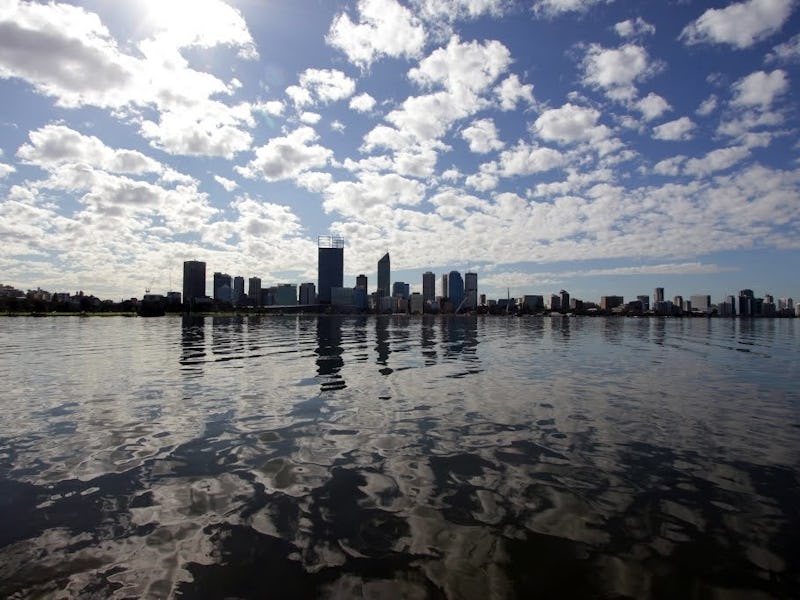FUTURE CITIES: Perth
Western Australia's capital is getting creative about water.

Citizens of Australia, the driest continent not named Antarctica, have grown accustomed to heatwaves and droughts. But as climate change exacerbates water shortages across the country, life could get a lot harder in some places — and the Western capital of Perth may suffer the most.
Perth, a wine-rich, crime-poor outpost on a seal- and shark-crowded sea, is on track to face a citywide shortage of drinking water by 2050.
“The accelerated pace of the drying climate is the biggest challenge Perth faces,” says Clare Lugar, spokesperson for The Water Corporation of Western Australia, the principal supplier of water, wastewater and drainage services in the region. “Since the 1970s, the city’s rainfall has reduced by around 15 percent, at the same time streamflows to dams have declined dramatically.”
The city has traditionally relied heavily on groundwater and artificial reservoirs created by dams, but as Western Australia’s harsh summers have become more and more extreme, these sources have become less reliable. In recent years, the city has turned increasingly to a technology once considered the realm of science-fiction: desalination.
“In 2015-16, water from Perth’s dams accounted for only 7 percent of total water supply, which shows the effect of the drying climate,” Lugar says. “Over the same period desalination was the largest source of water, contributing 47 percent of total supply. This marks the first time desalinated water has been the largest portion of our drinking water.”
Is this Perth sculpture about desalination? We can only guess.
Australians have long been a leader in desalination technology investment. The hope has been that reverse osmosis, a bunch of filters, and a whole lot of pressure can be used to make drinking water and agricultural opportunities, while also shoring up natural ecosystems. Climate change and the heat it has created have only raised the stakes.
“For Perth, desalination is the most economically and environmentally sustainable source of ‘new’ water,” says Dr. Wendell Ela, professor of desalination and water treatment at Perth’s Murdoch University. “The sustainability of Perth’s growth depends on better use of existing water resources, but it is nearly impossible to map out a multi-decade resource plan for Perth that does not also include new water.”
Despite its merits, desalination has a significant drawback: extraordinarily high energy requirements. The average plant requires 15,000 kilowatt-hours of power for every million gallons of fresh water that’s produced, which is enough energy to keep the lights on in around 400 homes for 24 hours straight. Today, Australia relies on coal to fulfill three-quarters of its electricity requirements, but an innovative new pilot scheme off the coast of Perth may soon provide a more sustainable solution to meet the country’s energy needs.
Using submerged buoys, Carnegie Clean Energy’s pioneering CETO technology (named after the Greek ocean goddess) captures kinetic energy from waves to provide a consistent and scalable power source. In addition to providing sustainable energy, the buoys filter salt out of the ocean and pump clean water into the city.
“Western Australia has the largest and most consistent wave energy resource in the world,” says Dr. Michael Ottaviano, CEO of Carnegie Clean Energy. “This – along with the fact that seawater desalination plants are by definition located near the ocean – makes Perth, and Australia, ideally suited for wave powered desalination.”
Carnegie's CETO 6 gets power from waves.
Successful trials and pilot schemes have proven the viability of the technology, but at the moment its use is limited to providing water and energy to a naval base on Perth’s Garden Island. Ottaviano estimates that all of Perth’s drinking water needs could be met by deploying just 200 CETO-6 units. But whether this will one day happen is ultimately down to whether the political will exists to spend on installation.
Australia has earned a reputation as the West’s worst carbon emitter per capita, and Perth ranks as the least green of the country’s largest 20 cities. Until Western Australia is able to reduce its reliance on existing desalination plants, or find renewable sources to power them, however, the city will be stuck burning coal to purify water.
This is, of course, a global issue. The UN forecasts that unless drastic action is taken, climate change will cause half of the global population to live in water poverty by 2030. With this basic resource becoming more scarce globally, innovative solutions like those developed off the coast of Perth could be vital in preventing widescale conflict and mass migration. Indeed, technologies developed in Western Australia are being already being exported to coastlines around the world.
So too will the rest of the world face Perth’s tradeoff between environmental need and environmental damage. Cities, like people, will do anything to quench their thirst.